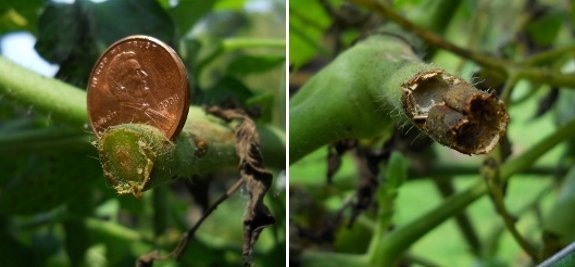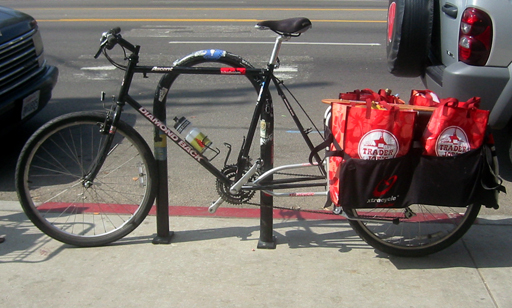
archives for 09/2012
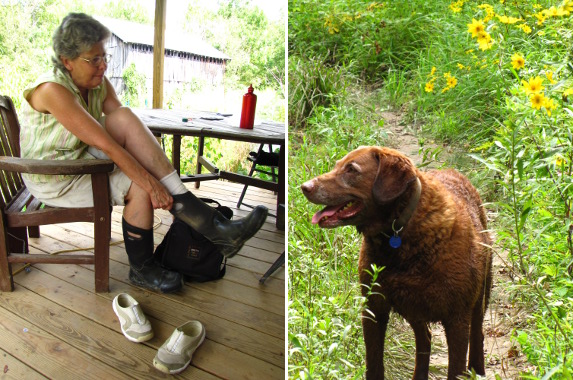
Mark and I went to the
courthouse Thursday to research a property that's one possibility for
the Annex. (One of these days
I'll make a real post about the Annex idea, but our dream is still
evolving and I don't want to tie it down yet.) Our title
search turned up a
disappointing document --- an oil and gas lease from 2003.
Lost mineral rights are
one of the main reasons to perform a title search. As a
landowner, you can sell some of your property rights while still living
on and farming your land, and those lost rights don't come back when
the property is passed on to another owner. In Appalachia,
selling mineral rights is common since many folks are living very close
to the financial edge, so a few thousand dollars now and a few hundred
every year from now on sounds good even if it means your well might be
polluted, your house might cave in, and strangers can tromp across your
land at will.

In our case, it's
possible the lease has expired --- I'm waiting until the holiday
weekend is over to hunt down that data. According to the contract
I read, the gas company needed to either start drilling or start paying
the landowner a certain amount within five years, and there's no sign
of a well on the property, so we might get lucky and not have to deal
with the issue.
But if the mineral
rights are no longer attached to the land, Mark and I will be faced
with a hard decision. This property is within easy walking
distance (unlike
another one we've considered), has lots of road frontage (making it
easy to hold public events there), and is south-facing. There are
also several acres currently being managed as hayfields, so it would be
relatively painless to install our dream orchard and pasture.
Finally, the property is assessed at $600 per acre, which is right up
my skin-flinty alley. (That's exactly what I paid for our current
ugly duckling farm.)
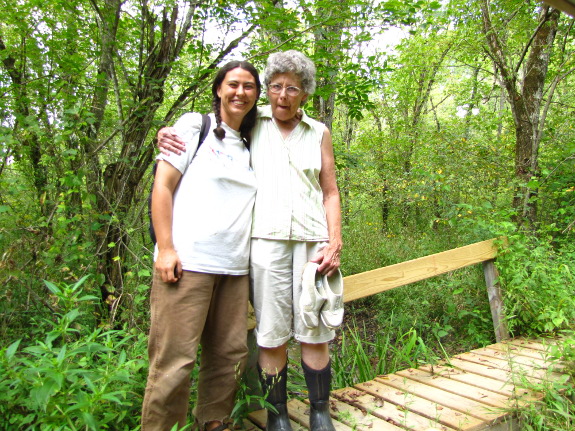
On the con side, the
soil is terrible (which I consider more of an interesting puzzle than a
real disadvantage) and there's no water. And then there's the
potential deal-breaker --- the lost mineral rights. So here's my
question for thoughtful readers --- would you ever consider buying a
piece of land without the mineral rights? If so, how would the
lost rights impact your financial decision?
(As a side note, the photos have nothing to do with this post, as you probably
guessed. Mark and I celebrated Labor Day on Friday by inviting
Mom over and we had a lovely time watching a Barred Owl, picking stick
tight flowers, and hanging out on the porch.)
Back in the early 2000's a
person could dump their trash around here during normal working hours,
and if they were so inclined take home a discarded lawn mower, give it
a little TLC, and feel good about recycling the old fashioned way.
It's different now.
Scavenging is not only discouraged, but it's treated as criminal
behavior. I'm not sure what the fine or jail time might be, but each
station now has an attendant to keep an eye out for scavengers.
I'm guessing the cost of
those attendants is what forced the reduced hours of operation. A major
drag when you drive all the way there and realize they closed at noon,
which is the main reason I took this picture. It helps that our new
helper has a permit to use multiple county locations, but still
requires some basic knowledge of these odd times.
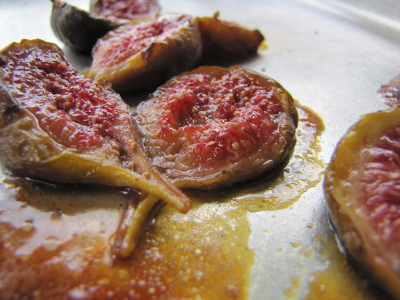 Last
week, I wrote that our first
homegrown fig was good, but not sensational. Roasting the next
four figs instead of eating them raw definitely popped them up into the
delectable category, though, which started me thinking (again) about
fig propagation.
Last
week, I wrote that our first
homegrown fig was good, but not sensational. Roasting the next
four figs instead of eating them raw definitely popped them up into the
delectable category, though, which started me thinking (again) about
fig propagation.
In our climate, a fig
"tree" is never going to be much more than a bush. Any branches I
don't protect
over the winter die
back, so the best case scenario is that our fig will expand upwards
from three foot tall trunks each spring. Since figs set fruit a
few at a time over a long season, that means our little fig bush will
be giving us four figs here and six figs there for a month or two,
which is clearly not going to be enough now that Mark and I have tasted
these homegrown fruits in their full glory.
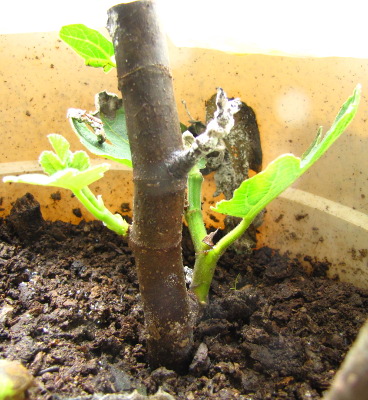 The
good news is that figs have turned out to be the most disease- and
insect-resistant fruits (tied with strawberries and brambles) in our
garden, so installing more won't require much effort after the initial
planting. In fact, I'd read that figs are relatively easy to
propagate from cuttings, so I half-heartedly tried a few hardwood
cuttings this spring. (If I'd known what the roasted fruits
tasted like, I would have put in a bit more effort.) While
pruning, I snipped off a few young branches and inserted them into a
pot, covering the top with a bag to hold in moisture. The
cuttings leafed out, but I think I removed the bag too soon because the
greenery ended up dying back and the figs petering out.
The
good news is that figs have turned out to be the most disease- and
insect-resistant fruits (tied with strawberries and brambles) in our
garden, so installing more won't require much effort after the initial
planting. In fact, I'd read that figs are relatively easy to
propagate from cuttings, so I half-heartedly tried a few hardwood
cuttings this spring. (If I'd known what the roasted fruits
tasted like, I would have put in a bit more effort.) While
pruning, I snipped off a few young branches and inserted them into a
pot, covering the top with a bag to hold in moisture. The
cuttings leafed out, but I think I removed the bag too soon because the
greenery ended up dying back and the figs petering out.
I'm curious to hear from
those of you who have successfully propagated figs. Did you use
hardwood or softwood cuttings? In the garden or in pots?
During what time of year? There's a plenitude of information
about fig propagation on the internet, but as usual, I'm looking for
the lowest tech solution possible, even if the success rate is only 20%
--- we've got plenty of scionwood to play with, but limited time during
the growing season.
I think the penny only stayed
in place for a few days, the picture on the right is from today
compared to the left one which is from last Sunday with the penny
installed for fighting tomato blight.
The plant still has some
blight, but the fruit looks healthy.
Maybe a modified paper clip
would be strong enough to hold it in place?
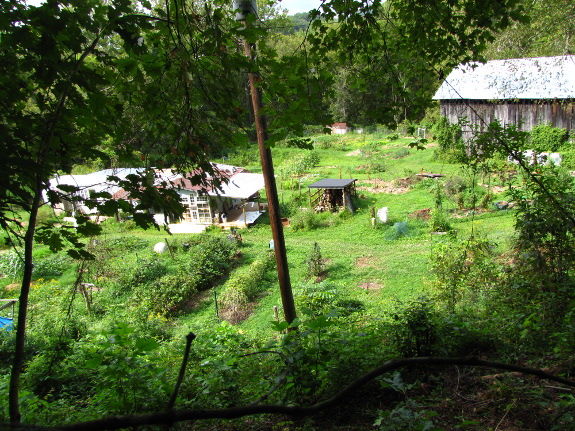
Mark and I don't
celebrate our anniversaries, but I always try to take an hour to bond
with the farm on our move-in date. This week marks the beginning
of the seventh year we've spent here, and the changes are more visible
than ever before.
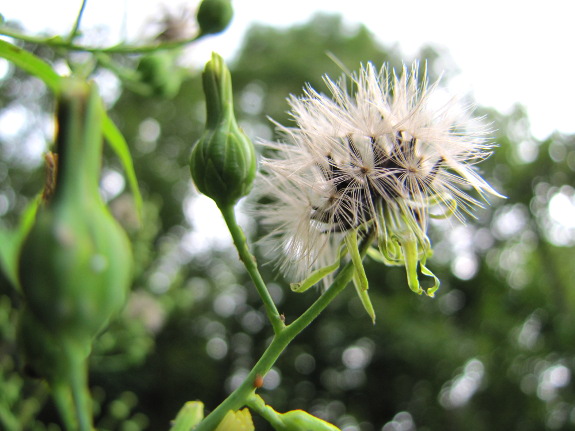
Although Bradley's hard
work dragging our infrastructure out of the trailer trash category is
the most obvious change photographically, what I find more significant
is that our tranquility levels are at an all-time high. I'm
tempted to explain that mood away by saying we're mostly caught up with
seasonal farm chores, but the truth is we're at about the same place we
were in previous years. The difference is one of attitude.
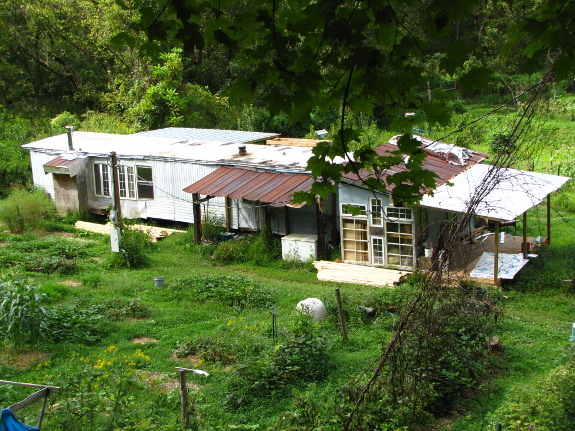
Previously, glancing at
a blighted tomato plant would send me into a tailspin, but this year
I'm starting to realize that we can manage the blight and still harvest
fruits well into the fall. True, constant mulching has lowered
the weeding pressure, but I think part of my contentment with the 2012
garden comes from realizing that a certain level of weeds won't take
over and can simply be ignored.
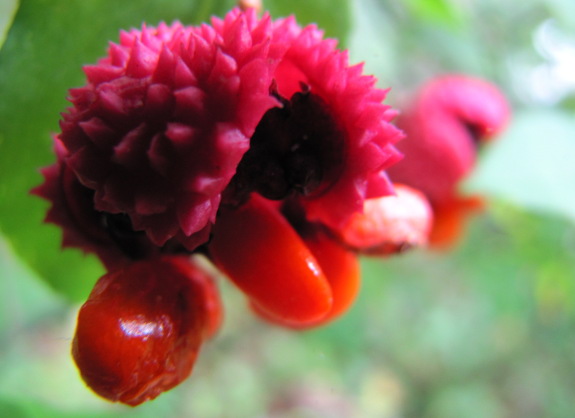
Meanwhile, we're looking
forward to another winter like the last one, when we focus on creative
pursuits instead of struggling to catch up on all the tasks we didn't
complete over the previous year. While there are always projects
on the back burner, the most pressing improvements are already in
place, and Mark and I are both learning to quash our greed for
expansion in favor of time for tranquility.
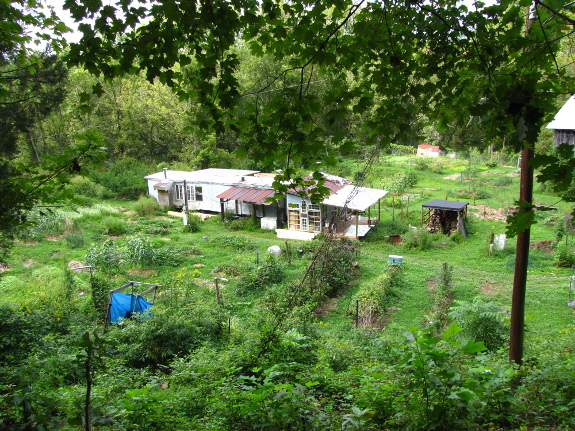
Which is all a long way
of saying that I'm able to look at last year's
anniversary post and
laugh at who I was then. (The pictures are worth a gander,
though, since they sum up the changes in our farm over the years quite
succinctly.) Thank you, farm, for helping me grow along with my
vegetables!
 The
Humanure Handbook is
another book that epitomizes self-publishing. There are some
flaws here and there --- rants that will turn 80% of the audience off
and scattered trains of thought --- but the positives far outweigh the
negatives. Instead of producing a book watered down
for the masses,
Joseph Jenkins has distilled his passion for composting toilets into
250 pages of essential reading for the serious humanure advocate.
(Plus, there are fun cartoons.)
The
Humanure Handbook is
another book that epitomizes self-publishing. There are some
flaws here and there --- rants that will turn 80% of the audience off
and scattered trains of thought --- but the positives far outweigh the
negatives. Instead of producing a book watered down
for the masses,
Joseph Jenkins has distilled his passion for composting toilets into
250 pages of essential reading for the serious humanure advocate.
(Plus, there are fun cartoons.)

Due to our book club Wednesdays
and popular meat
rabbit Tuesdays, my
humanure lunchtime series is going to be scattered across the next two
weeks. That gives you plenty of time to pick up a copy and read
along...especially since you can download a
digital version entirely free. Stay tuned to learn
why we don't compost our humanure yet and what kind of system we'd like
to use if and when we do.
| This post is part of our The Humanure Handbook lunchtime series.
Read all of the entries: |
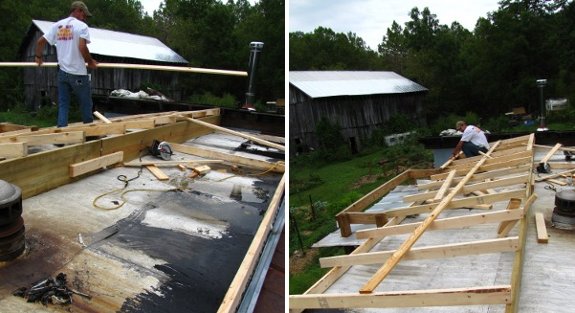
We've been having problems
with our roof leaking ever since someone gave us this trailer about 6
years ago.
I can't count how many times
I "fixed" a leak with roofing tar only to have it come back in a few
years.
The new trailer roof project
will not only take care of that problem but will cut back on wood
burned and split with the extra insulation we plan to install.
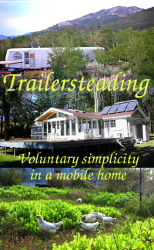
Edited to add:
Learn more about insulating and improving the efficiency of a mobile
home in Trailersteading. Now available on Amazon.
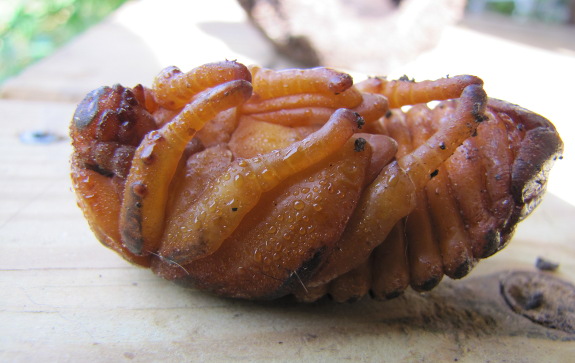
Somehow in the rush of
early June, I seem to have forgotten to post about the world's largest
grub, found by Bradley in the horse
manure as he
shoveled the biomass into buckets to be transported to our worm
bin. While I
do exaggerate slightly, the grub Bradley found was significantly larger
than a June bug larva, and we took the time to toss it in a flower pot
in hopes of learning what the plump youngster would turn into.
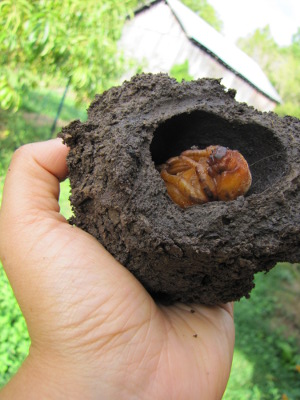 Saturday,
I decided to find out whether there was any life left in my fig cuttings,
so I dumped out the contents of that pot. And broke open a
fist-sized ball of dirt that housed a pupating beetle! The insect
was even larger than it had appeared on last viewing, so I carefully
fit its pupal chamber back together and refilled the pot, hoping the
tween will manage to make it to adulthood despite my poking and
prodding.
Saturday,
I decided to find out whether there was any life left in my fig cuttings,
so I dumped out the contents of that pot. And broke open a
fist-sized ball of dirt that housed a pupating beetle! The insect
was even larger than it had appeared on last viewing, so I carefully
fit its pupal chamber back together and refilled the pot, hoping the
tween will manage to make it to adulthood despite my poking and
prodding.
Mark's original idea
after seeing the size of the grub was to raise the species for chicken
feed, but I suspect the experiment wouldn't really work out. Stag
beetles usually spend several years in the larval stage, which would
make propagating them a slow affair, despite the amount of nutrition
each beetle would provide for our flock.
All utilitarian reasons
aside, we're itching to see the adult version of this hefty
critter. I suspect the stag beetle it turns into will be
awe-inspiring.
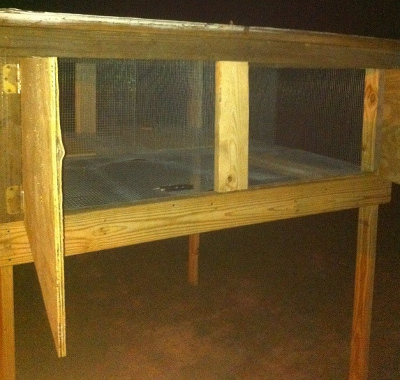 Before
we could actually bring any rabbits home, we had to build a hutch. I've
had some ideas in my head for how to
construct one, but, as things usually go, we ended up building the hutch
based on the materials we had at hand.
Before
we could actually bring any rabbits home, we had to build a hutch. I've
had some ideas in my head for how to
construct one, but, as things usually go, we ended up building the hutch
based on the materials we had at hand.
Dawn had
found two shed doors on the side of the road...and that ended up
determining the dimensions of the hutch we built. We used the shed
doors as the roof, and we'll later cover these with some tin for
longevity.
The hutch is approximately 6 feet by 7 feet, and
it's quartered into four separate spaces of roughly 3 feet by 3.5
feet. The hardware cloth I purchased was 2 feet tall, so that
ended up being the vertical dimension of the living area.
Dawn had also found some scrap 2x4s and plywood that we were able to
press into service for the hutch. The plywood became doors, and 2x4s
became the frame. I
purchased a few more 2x4s and two 2x6s at the local supply house. The
end product ended up being a quite robust hutch that stands about 6
feet tall, with a footprint of about 6x7.
Sorry about the quality of
the photo, it was about 9:30 at night when we
finished the hutch. We used a 2x6
across the lower support so that it will hold up a bit better over
time. The uprights are 2x4s, the roof is 1/2 inch plywood, and the
hardware cloth is 1/2 inch in order to allow the pellets to drop
through.
One of the major goals of raising rabbits here will be
to use the manure in the garden. We have very poor soil, so
anything we can add to it will greatly benefit my plants.
All in
all, I think the hutch cost us under $100 in material. Considering we
should be able to get many litters of rabbits out of it, the structure
will eventually pay for itself, I hope.
Shannon and Dawn will be sharing their experiences with raising meat rabbits on Tuesday afternoons. They homestead on three acres in Louisiana when time off from life and working as a sys admin permits.
Big, big, really big sweet
potatoes this year, bigger than those big
ones from 2010.
In part due to having almost
zero deer damage this year.
We actually might have a few
extra that will need to find a home.
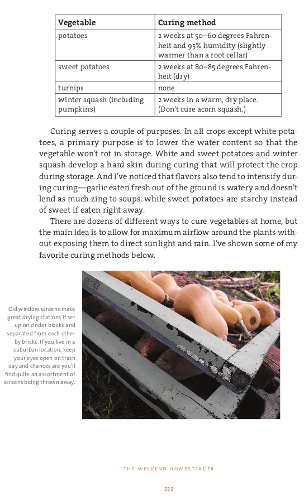 When I posted last week about
the first
copies of my book arriving, I was too excited to give
you any details. Now that I've calmed down a bit, I should start
with the semi-bad news --- you're going to have to wait longer than I'd
originally thought to see The
Weekend Homesteader
in bookstores (and in your mailbox). My publisher decided to push
the release date back to November 13 to give them time to get some buzz
going, and to take advantage of holiday sales.
When I posted last week about
the first
copies of my book arriving, I was too excited to give
you any details. Now that I've calmed down a bit, I should start
with the semi-bad news --- you're going to have to wait longer than I'd
originally thought to see The
Weekend Homesteader
in bookstores (and in your mailbox). My publisher decided to push
the release date back to November 13 to give them time to get some buzz
going, and to take advantage of holiday sales.
Here's the good news ---
some of you may not have to wait. My publicist is willing to send
out some advance copies of the book for bloggers to review and/or give
away. I'm not sure how many books
that offer encompasses, but I figure it can't hurt to send him
information about any of my readers who are interested in reviewing The Weekend Homesteader on
their blog. Just email me
the URL of your blog and any relevant statistics that will make you
stand out from the pack, and I'll pass the information on to my
publisher ASAP. Thanks for your interest!
 The second chunk of Radical
Homemakers continued
the
historical journey begun in the first two chapters, but I'd like to cut to the
chase and instead discuss Hayes' conclusions. She wrote that
three "homewreckers" are responsible for many of the ills in modern
American society: "the compulsion to overwork, the reckless pursuit of
affluence, and the credo of individualism."
The second chunk of Radical
Homemakers continued
the
historical journey begun in the first two chapters, but I'd like to cut to the
chase and instead discuss Hayes' conclusions. She wrote that
three "homewreckers" are responsible for many of the ills in modern
American society: "the compulsion to overwork, the reckless pursuit of
affluence, and the credo of individualism."
In my opinion,
overworking and trying to get rich are closely related topics, and I've
discussed them both in some depth before. For example, Hayes
agrees with others that income
does not necessarily equate to happiness, and adds that despite the
price tag attached to renewable energy, poor people in general tread
more lightly on the earth. If you haven't read about and thought
this issue to death previously, I definitely recommend you look through
Hayes' data to see if it speaks to you.
Although I agree with
her about the problematic American work ethic, the most
thought-provoking part of Hayes' argument came at the very end.
The dream household for a modern American, asserts Hayes, is large
enough to allow each family member to hide away with a television in
his or her own room, spending little time interacting with the rest of
the family or community. She relates that only seven percent of
American families spend more than half an hour at family dinners and
that the average American couple has only twelve minutes a day to
converse. As a nation, we are not only pursuing money, but also
independent privacy at the expense of a society centered around
skill-learning and social-capital-earning.
Mark and I are above
average when it comes to building the health of our two-person
household, but we still struggle with creating an
interdependent community (one of our big goals for
the next decade). I'd be curious to hear which of these
homewreckers you find most troublesome in your own life, and ---
zooming back out to the larger picture --- I hope you'll chime in on
whether you agree with Hayes' setup of the problem. There were a
lot 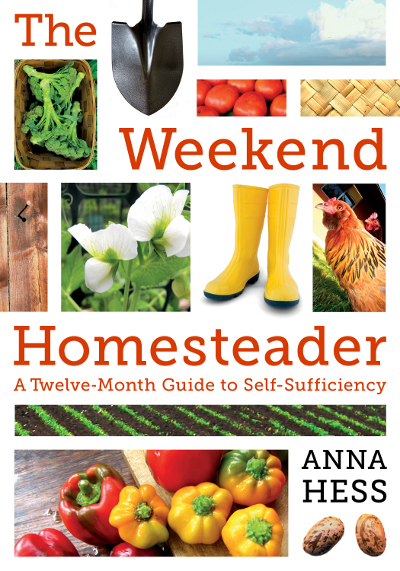 of other things to think
about in these two chapters as well, so feel free to bring up points
I've skipped here.
of other things to think
about in these two chapters as well, so feel free to bring up points
I've skipped here.
We'll be discussing
"Meet the Radical Homemakers" and chapter five next Wednesday, which
will start to bring us back out of the land of theory. (If you
get sick of pure philosophy the way I often do, this might be a good
place for you to start the book.) Newcomers are always welcome to
join the club!
The
Weekend Homesteader is now
in print! (Your copy probably still won't arrive for a couple of
months though.)
We've been hauling in enough
horse manure to fill all 3 new worm
bins along with the salvaged
stock tank.
A little bit of hindsight is
showing me that a slight increase in surface area might allow us to add
on 2 more buckets up front while snugging them all better for a more
secure ride.
Funny how so much horse
manure can make you feel extra wealthy.
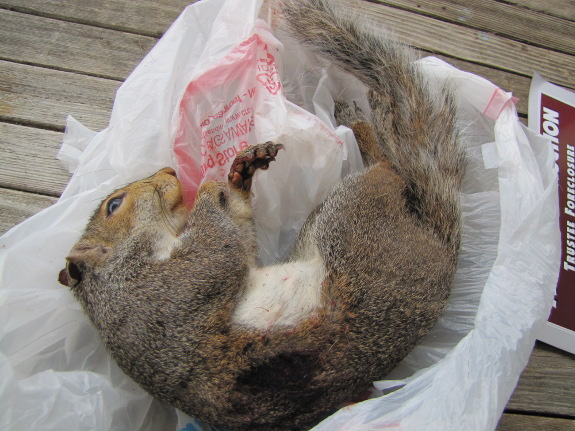
Bradley knows that Mark
and I are interested in trying out more kinds of wild game, so he
kindly brought a squirrel to work with him Wednesday morning. He
had shot it the night before, so the body had gone stiff overnight in
the fridge and took five minutes to skin --- a long time compared to
the one minute Bradley estimates it usually takes him.
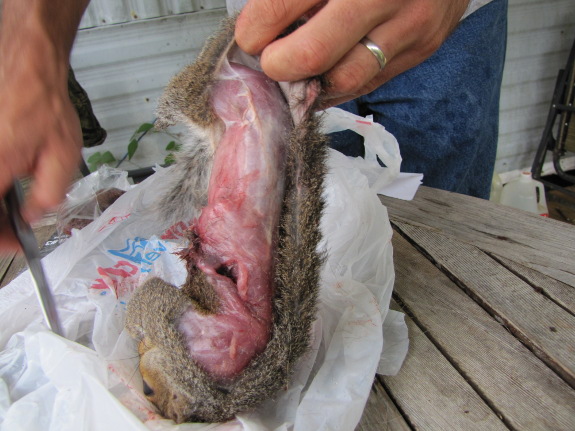
After Bradley
illustrated the proper skinning and cleaning technique, we chopped the
carcass up into thirds as suggested and boiled the meat to provide our
lunch. Unfortunately, neither Mark nor I were thrilled by the
taste. I could have spiced it up relatively easily, but wanted to
get an idea of what squirrel really tasted like, so left it plain.
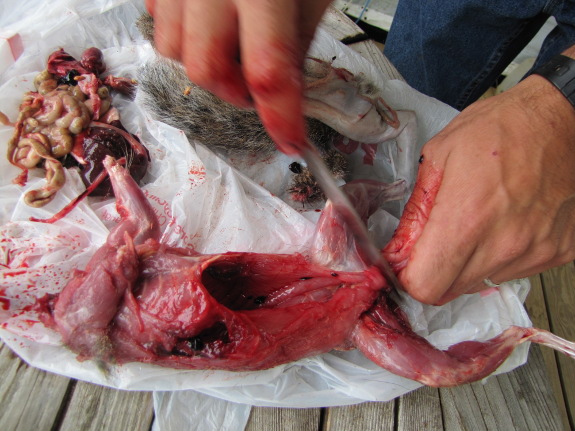
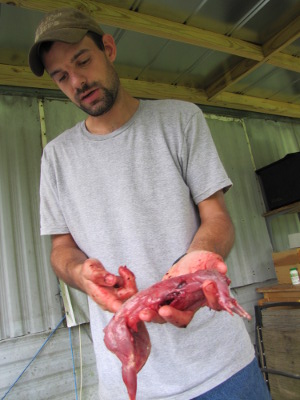 I'm not sure our analysis of
the flavor was really fair, though. When I was able to pretend I
wasn't eating squirrel, I thought it tasted a bit like chicken, but for
some reason the idea of eating a squirrel didn't sit well with
me. I don't think Mark was able to divorce the idea of "squirrel"
from what was on his plate at all.
I'm not sure our analysis of
the flavor was really fair, though. When I was able to pretend I
wasn't eating squirrel, I thought it tasted a bit like chicken, but for
some reason the idea of eating a squirrel didn't sit well with
me. I don't think Mark was able to divorce the idea of "squirrel"
from what was on his plate at all.
In a pinch, I'm now
confident that I could skin and gut a squirrel, and I suspect that
hidden in a pot of vegetable soup, neither of us would have any
complaints about squirrel meat. But for now, we're going to stick
to cultivated meat and venison, with the idea of rabbit still floating
around for later.
(As a side note, Lucy
was far more interested in the squirrel hide, head, and entrails than
she usually is in offal. Sounds like she, at least, has no
problem wrapping her head around eating squirrel.)
 Before we dive into
composting humanure, it's worth understanding what happens to your crap
if you are plugged into a conventional system. Your waste is
commonly known as sewage, but in the industry, it's generally referred
to as wastewater (or possibly blackwater if you're making a distinction
between the output of your toilet and sink). Wastewater disposal
methods range from the simple to the complex, and Jenkins does a good
job of pointing out the pros and cons of each system.
Before we dive into
composting humanure, it's worth understanding what happens to your crap
if you are plugged into a conventional system. Your waste is
commonly known as sewage, but in the industry, it's generally referred
to as wastewater (or possibly blackwater if you're making a distinction
between the output of your toilet and sink). Wastewater disposal
methods range from the simple to the complex, and Jenkins does a good
job of pointing out the pros and cons of each system.
The cheapest way to
dispose of human waste is the pit latrine, which is basically our
system at the moment. The worst problem with a pit latrine is its
tendency to leak pollutants into the groundwater, which is why an
outhouse should always be more than fifty feet away from any well or
stream. Assuming you work around that issue, other problems
include disease-transmission, annoying flies, and smell, all of which
can be avoided by keeping the humanure covered with a high carbon
material after each use.
If your outhouse isn't
grandfathered in like ours, you'll be forced to install a septic system
in most parts of the United States. Septic system owners use a
conventional toilet inside the house, then the wastewater flows to a
septic tank for solids to settle out. The liquid continues on to
a leach field, which is simply a series of buried pipes that let water
drain out into the subsoil.
The biggest disadvantage
of septic systems, in my opinion, is cost, since even the cheapest
onces will set you back at least $2,000. In addition, you have to
 pump the solids out of the
septic tank at intervals, and that material ends up being sent to a
wastewater treatment plant, which has its own problems. Finally,
Jenkins notes that concentrations of more than 40 septic systems per
square mile lead to subsurface contamination, which means that if you
and your neighbors have lots smaller than about 16 acres, septic
systems are a bad choice. (I suspect this same issue would come
into play with pit latrines/outhouses.)
pump the solids out of the
septic tank at intervals, and that material ends up being sent to a
wastewater treatment plant, which has its own problems. Finally,
Jenkins notes that concentrations of more than 40 septic systems per
square mile lead to subsurface contamination, which means that if you
and your neighbors have lots smaller than about 16 acres, septic
systems are a bad choice. (I suspect this same issue would come
into play with pit latrines/outhouses.)
In the city, wastewater
is pumped to a central treatment facility, which can use any of several
methods to treat the human waste. I won't go into wastewater
treatment plants much here since I doubt any of you are thinking of
installing one in your backyard, but Jenkins explains in great depth
why the facilities are problematic. In addition to the puzzle of
disposing of organic matter laced with toxins (due to treatment) and
the chlorinated effluent harming receiving streams, we waste energy by
treating water and then using it to flush our toilets.
The Humanure Handbook
asks us to step back and change our view of humanure. If we
consider our effluent to be a valuable form of organic matter rather
than something to dispose of, we can create systems that recycle
humanure into apples. Yes, humanure composting systems require a
little more time, but they also use less money and create less
pollution, so they fit the homesteading ethic to a T.
| This post is part of our The Humanure Handbook lunchtime series.
Read all of the entries: |
It took us a little over 2
hours to shuttle the new roofing tin from our parking area back to the
trailer.
The color we chose is called
Lightstone, and the manufacturer claims it should last at least 40
years at a cost of $1.87 per foot.
Be sure to check back with us
in 40 years for a detailed report on the exact condition of the metal
and how well it holds up over the next 4 decades.
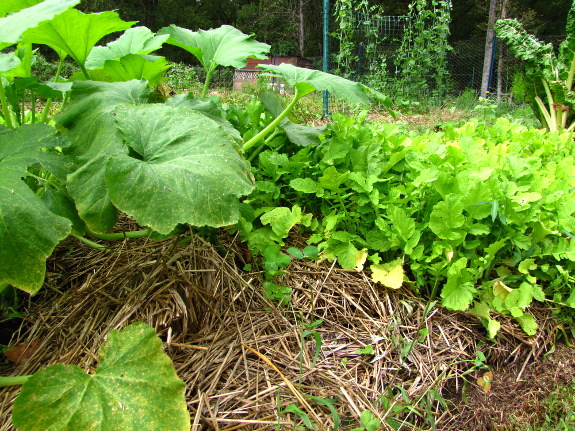
This week is our last
chance to plant oilseed radishes, so I made a lot of hard-nosed
decisions. For example, I ripped out all of the older beds of
beans and just kept one to enjoy until the frost --- I'd rather miss
out on some subpar beans than lose a whole season of
cover-cropping. Similarly, the oilseed calendar is the main
reason I harvested
my sweet potatoes
this week, since I wanted to be able to put cover crops in the tubers'
place.
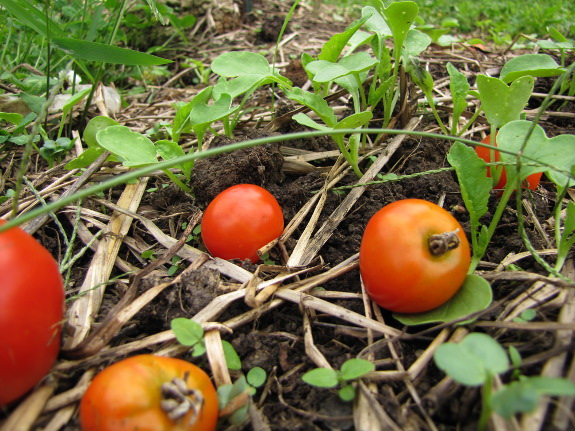
Meanwhile, I slipped
oilseed radishes into gaps where fall crops didn't come up, and I even
pulled back the mulch and tossed down seeds around sweet corn that will
be done bearing this week and around tomatoes that look too blighted to
last much longer. Since my new method of cleaning up after large
crops involves cutting the spent plants at ground level and leaving the
roots in place, removing the finished vegetables won't disrupt the
radish seedlings. And I figure the oilseed radishes won't get big
enough to compete before the corn and tomatoes are done.
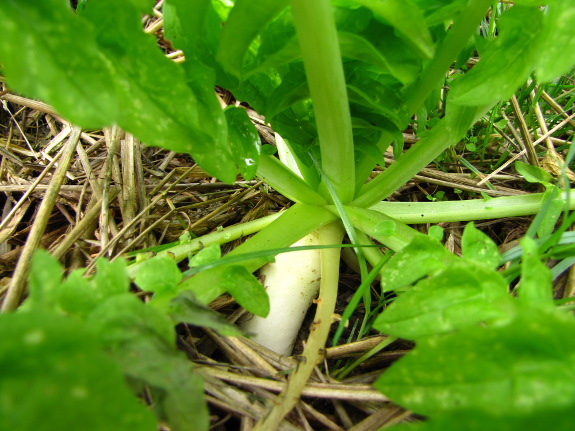
Since Mark talked me
into splurging on 25 pounds of oilseed radish seeds, I'm trying out
some crazy experiments too. I
seeded an entire chicken pasture in oilseed radishes and planted some radishes
around the base of a young apple tree. I'm not too thrilled with
the pasture planting --- I think the shade set the cover crop back --
but the apple has sparse enough leaves that I think it might coexist
quite well with the radishes.
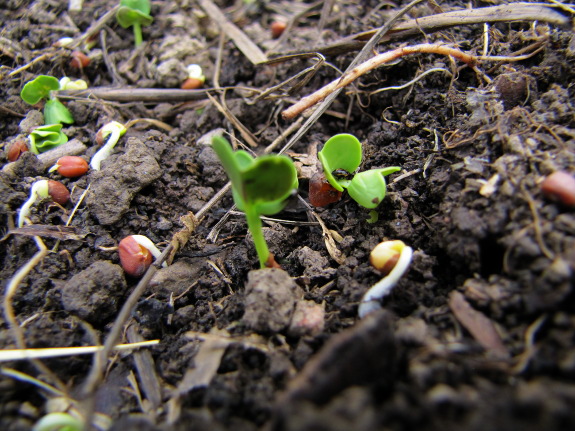
Unlike buckwheat seeds
(which get eaten up by cardinals in short order
if I don't sprinkle a light coating of straw over top after planting),
radish
seeds don't seem to be enjoyed by wildlife. So I simply scatter the
radish seeds on the soil surface by eye, often ending up seeding
thicker than I really should (like in the photo above). I figure
it's worth a bit more seed to keep effort to a minimum.
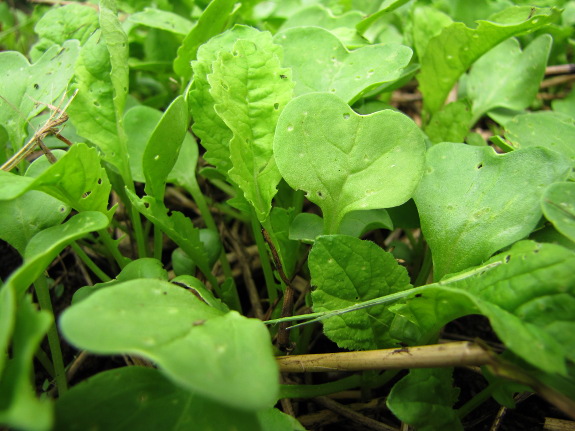
All told, I used 12
pounds of oilseed radish seeds this year, which cost about $43.
If I figure I planted about 5 pounds of that in 27 beds in the garden
(with the rest going into the pasture), that comes to 66 cents per bed,
compared to maybe 83 cents per bed if I overwintered the garden by
mulching it with straw. Of course, it
would be considerably cheaper to use oats as our winter cover crop, but we wanted to give
oilseed radishes a more serious try this year to see if they're worth
the extra money.
In case you haven't been
following along for the last couple of years, here are some relevant
posts about oilseed radishes:
- The
potential of oilseed radishes
- My two favorite no-till winter cover crops
- When to plant oilseed radishes
- How
to kill no-till cover crops
- What oilseed radishes look like in February
- Organic matter production of my favorite cover crops
- Improving soil with cover crops
- Choosing
cover crops
Hopefully that'll
inspire you to try out some cover crops in your garden, if not this
year, then next.
 Next week, I'll continue our
humanure lunchtime series by delving into several different types of
composting systems. However, before you get too excited, I want
to take a step back and consider the biggest issue with humanure
composting.
Next week, I'll continue our
humanure lunchtime series by delving into several different types of
composting systems. However, before you get too excited, I want
to take a step back and consider the biggest issue with humanure
composting.
No, I'm not talking
about disease. Joseph Jenkins does an admirable job of explaining
how a well-managed humanure recycling system is perfectly safe.
(Check out The
Humanure Handbook if
you don't believe me.) I'm more concerned with an issue that's
already problematic on our farm --- a paucity of high
carbon materials.
 We've been experimenting with deep
bedding in our
chicken coop for the last couple of years, which is a bit like a
humanure composting system for chickens. Theoretically, the idea
has merit, and it does work pretty well in practice, but I'm always
scrambling in search of quality bedding.
We've been experimenting with deep
bedding in our
chicken coop for the last couple of years, which is a bit like a
humanure composting system for chickens. Theoretically, the idea
has merit, and it does work pretty well in practice, but I'm always
scrambling in search of quality bedding.
In a pinch, I can use straw, but I don't like buying carbon for my
chickens to poop on, and the optimal bedding is higher in carbon and
smaller in size so chickens can scratch through and mix the bedding
regularly. When we run out of autumn leaves, either raked from
the woods or collected by my kind mother during city trash pickup days,
manure piles up, smells turn foul, and flies start to plague our porch
dinners. The conclusion is: we don't have enough high carbon
materials for essential uses right now without diverting some to a
humanure composting system.
Jenkins recommends
hunting down 20 cubic feet of sawmill sawdust per hundred pounds of
human body weight in the household per year, which (rounding up to
include guests and to give us a bit of wiggle room) would equate to 80
cubic feet (600 gallons) for us. That's 120 five gallon buckets
or 7 of our 95
gallon wheelie bins full --- a pretty hefty helping of sawdust for
which
we've yet to find a source. In addition, he recommends having
about ten bales of straw or hay on hand for covering the outdoor
pile. (I'll explain more about the uses of the two types of high
carbon material in a later post.)
 Jenkins does offer sawdust
alternatives, including peat moss, leaf mould, rice hulls, or grass
clippings (although I'm not so sure grass clippings would work well ---
they're pretty high in nitrogen). However, all of those sources
would either have to be bought or would require considerable effort to
gather, making their use equally problematic.
Jenkins does offer sawdust
alternatives, including peat moss, leaf mould, rice hulls, or grass
clippings (although I'm not so sure grass clippings would work well ---
they're pretty high in nitrogen). However, all of those sources
would either have to be bought or would require considerable effort to
gather, making their use equally problematic.
Mark isn't a fan of humanure composting, so he was very relieved when I
told him I couldn't even consider a system until we stock up on enough
high carbon bedding for the chickens plus a year's supply for a
humanure system. Looks like we'll be scouring the countryside in
search of a sawmill....
| This post is part of our The Humanure Handbook lunchtime series.
Read all of the entries: |
We've got a new batch of
fresh chicks. The last one of 2012.
They seem to have made
themselves at home and look at the new observation window with
curiosity.
Maybe being curious at such a
young age will make them better at foraging for bugs?
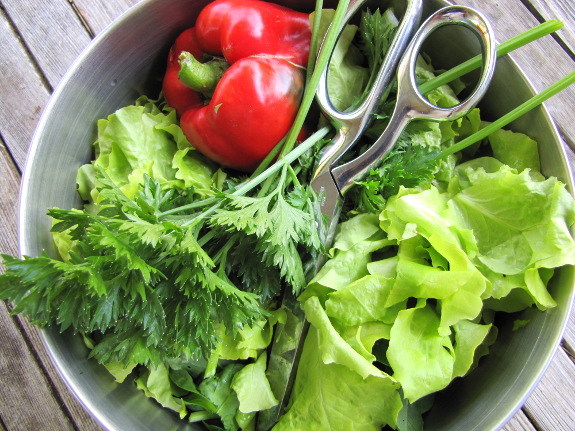
Celery is one of the
herbs/vegetables I used to eat a lot, but found too nitpicky to grow in
my garden. Luckily, I discovered that parsley fills in very well
as a substitute in soups and salads during the spring, fall, and
winter, although in the middle of summer, the herb becomes too woody
and strong to be pleasant raw.
This year, I decided to
try a new celery substitute for those hot summer months --- Par-cel
cutting celery, an heirloom herb dating back to eighteenth century
Netherlands. Cutting celery looks a lot like parsley, with small
stems and lots of leaves, but tastes more like celery. I found
the ribs and leaves very pleasant in tuna salad this year, but would
warn you that if you don't like the slightly bitter taste of celery
leaves, you won't like cutting celery --- there are a lot more leaves
than stalks.
The other downside of
cutting celery is that it didn't seem to want to germinate when
direct-seeded at the frost-free date in my garden. Out of my
small trial packet of 200 seeds, I only ended up with two plants.
If you want to try it out, I suspect that cutting celery might be
better started in flats so you can keep the moisture levels just right
for speedy germination.
We replaced the
old 12
amp Skil saw with the
next step up this week.
The main lesson I learned is
to keep an eye on the sharpness of the blade and to put a fresh one on
before it's too late.
It came with a nice tote bag
that could double as a purse for the ladies out there with an
industrial twist to their fashion sense. Perfect for date night when
you want to sneak a six pack of beer into the theatre.
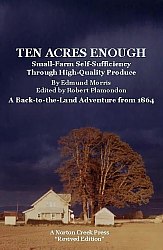 Ten
Acres Enough was
originally published in 1864, but the farming memoir stands the test of
time extremely well. I picked up the Norton Creek Press edition,
which includes Robert Plamondon's occasional footnotes and careful
calculations of what the original dollar amounts would come to in
today's terms. If you don't mind foregoing those small
conveniences, though, you can
read the book online for free.
Ten
Acres Enough was
originally published in 1864, but the farming memoir stands the test of
time extremely well. I picked up the Norton Creek Press edition,
which includes Robert Plamondon's occasional footnotes and careful
calculations of what the original dollar amounts would come to in
today's terms. If you don't mind foregoing those small
conveniences, though, you can
read the book online for free.
Those of you who were
struck by the careful use of organic matter in Farmers
of Forty Centuries
will be intrigued by Edmund Morris's fascination with manure. His
first year on the farm, he spent $248 on manure ($5,700 in today's
dollars), and when he had more money on hand, he was happy to part with
$358 ($8,228 today) for manure during his third year. He chose to
keep his livestock completely confined and cut
clover from his field to feed them as a way of maximizing his homegrown
manure production, and he also collected tree leaves from the wild to
add to the compost pile. All told, perhaps a third of Ten
Acres Enough is
devoted to discussions of organic matter.
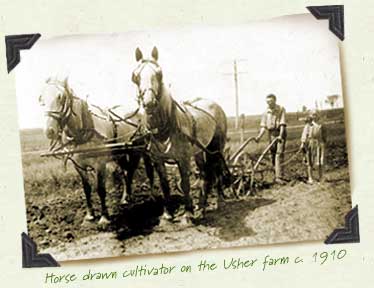 The larger theme, though, is
how to make a simple but dependable living on a ten acre farm. I
doubt that an American farmer could follow Morris's lead today due to
competition with factory farms, but some of his points are just as
valid now as they were a century and a half ago. Morris believed
strongly that debt is the downfall of many a businessman (since he
struggled against the problem for the first many years of his
life). He was also keen on focusing on a quality product (unique
if possible) marketed to a wealthy urban clientele.
The larger theme, though, is
how to make a simple but dependable living on a ten acre farm. I
doubt that an American farmer could follow Morris's lead today due to
competition with factory farms, but some of his points are just as
valid now as they were a century and a half ago. Morris believed
strongly that debt is the downfall of many a businessman (since he
struggled against the problem for the first many years of his
life). He was also keen on focusing on a quality product (unique
if possible) marketed to a wealthy urban clientele.
In the introduction,
Robert Plamondon describes this classic text as follows: "Ten
years after Henry
David Thoreau
learned how to be a poor farmer, Edmund Morris learned how to be a good
one." I totally agree. If you're interested in a glimpse
into American small farm life in the 1850s, this quick and fun read is
the book for you.
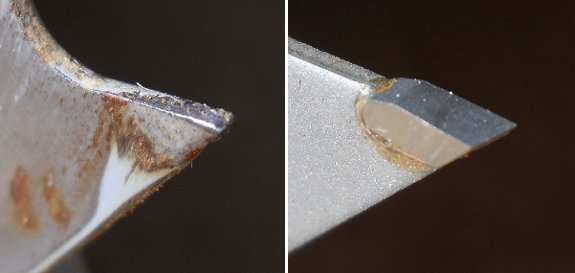
The main symptom of a dull
circular saw blade is the motor bogging down making cuts harder to push
through.
Above is a side by side
comparison of our old 12
amp Skil saw blade and a
brand new carbide tipped blade.
Maybe a circular saw from the
future will have a feature where it scans each tooth and shuts down or
beeps when the dullness is too much for the motor to handle.

One of our goals in
creating the Walden Effect Annex is to build our community, either by
bringing in likeminded folks from outside the area or by tempting
intriguing locals to come out of the woodwork. While the Annex
remains a work in progress, Mark and I made a start on the second goal
this weekend by creating a Meetup group --- the Extreme
SW Virginia Permaculture Guild.
Do you want to learn more about forest gardening, homegrown edible mushrooms, top bar hives, or vegetable varieties that do well without chemicals? Do you want to talk to someone who's heard of Paul Stamets, Joel Salatin, or Bill Mollison (and maybe bring one of these experts to speak in our region)? Perhaps you'd like to meet up with folks interested in creating a cowshare or intentional community? If so, this group is for you, no matter how little or much experience you've had with permaculture in the past.
We're currently planning a seed swap full of heirloom tomatoes, locally adapted garlic, old-timey beans, and much more, with date and location to be announced on the meetup group soon. Everyone who lives within driving distance of Dungannon, Virginia, is welcome to join --- just follow the link and click the "Join us!" button in the upper right hand corner of your screen. I'm looking forward to meeting you soon.
Our POOP-free chicken waterer is sponsoring the first year
of Meetup fees, so membership is free.
 Before The
Humanure Handbook
hit the stage, most of the systems in practice were cool composting
toilets. In contrast to Jenkins' thermophilic composting system
(which I'll discuss in Thursday's post), these cool composting systems
relied on time to kill off any pathogens in the humanure.
Before The
Humanure Handbook
hit the stage, most of the systems in practice were cool composting
toilets. In contrast to Jenkins' thermophilic composting system
(which I'll discuss in Thursday's post), these cool composting systems
relied on time to kill off any pathogens in the humanure.
In general, leaving a
pile of humanure to compost for two years is a sufficient safety margin
even if the pile doesn't heat up at all, although roundworm eggs can
survive for up to ten years under these conditions. If you apply
composted humanure under the mulch around ornamentals or fruit trees,
though, this issue may not matter.
The Clivus Multrum is
probably the best known of the cool composting systems, and most of the
other designs work similarly. Jenkins recommends designing a cool
composting toilet with at least two chambers so you can close off one
after filling and let the humanure age for a couple of years before
removing the compost. When starting a new chamber, fill it about 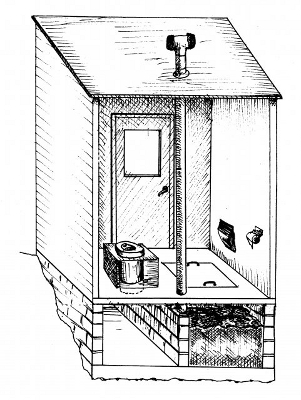 halfway with an
absorbent, high carbon material, then keep more of the
sawdust on hand to drop down the hole after each use. A
chimney-pipe-type ventilation system will pull any smells up above
nose-level, and leachate can be collected in a five gallon bucket of
sawdust that is tossed back down the hole at intervals.
halfway with an
absorbent, high carbon material, then keep more of the
sawdust on hand to drop down the hole after each use. A
chimney-pipe-type ventilation system will pull any smells up above
nose-level, and leachate can be collected in a five gallon bucket of
sawdust that is tossed back down the hole at intervals.
Despite the problem with
using humanure compost from this type of toilet on food crops, it does
have a major advantage --- simplicity. Unlike Jenkins' system,
there's little regular maintenance required beyond finding sawdust, and
the compost is high quality after the extended aging period.
I'd be curious to hear
from anyone who's using a cool composting system like this. What
design did you use (or what brand did you buy)? How has it worked
out for you? Do you have additional pros and cons to add to this
description?
| This post is part of our The Humanure Handbook lunchtime series.
Read all of the entries: |
The framing should be
finished up tomorrow on the mobile
home roof project.
Insulation and metal after
that will make the winter warm and drip free.
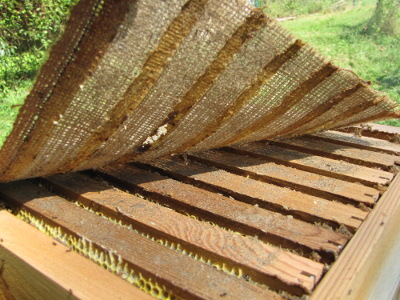 When I delved into the Warre hive for the first time last
week, I learned why I sometimes see Warre beekeepers with a wire tool a
bit like a cheese-slicer. The boxes aren't as keen on coming
apart as Lanstroths are, so I accidentally ripped part of a few combs
in half when they stuck to the top bars of the hive body below. I
guess I'll have to rig some kind of wax-slicer for the next time I open
the hive...a year from now.
When I delved into the Warre hive for the first time last
week, I learned why I sometimes see Warre beekeepers with a wire tool a
bit like a cheese-slicer. The boxes aren't as keen on coming
apart as Lanstroths are, so I accidentally ripped part of a few combs
in half when they stuck to the top bars of the hive body below. I
guess I'll have to rig some kind of wax-slicer for the next time I open
the hive...a year from now.
In the meantime, we'll
be pouring
sugar water down the bees' gullets to make sure they double
their winter
stores in the next
month. Except for only having only one box full of 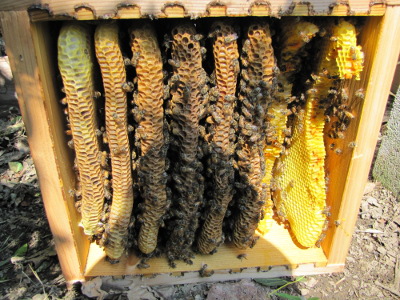 honey,
the hive looked quite healthy, with a lot of new workers about to hatch
out and get to work collecting ragweed pollen and goldenrod nectar.
honey,
the hive looked quite healthy, with a lot of new workers about to hatch
out and get to work collecting ragweed pollen and goldenrod nectar.
I also noticed that my ant
problem had been
taken care of with a biological control --- a skink moved into the
quilt. I love how the neglect method solves so many farm pest
problems.
We bought all of
Bradley's father's honey this summer since we want our bees to keep
everything they produce during their first year. I'm debating
splitting the hive next year and spending another year without
homegrown honey, or trying to find a local nuc next spring to increase
our apiary while allowing this first hive to feed us. Even though
the decision seems far in the future, we learned the hard way that
tracking down local bees should be started early, so we'll probably
choose between our options soon.
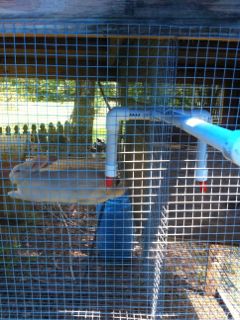 When keeping any animal, one of
the necessities is, of course, providing food and water. This post will
cover how I am providing water for my rabbits.
When keeping any animal, one of
the necessities is, of course, providing food and water. This post will
cover how I am providing water for my rabbits.
The result of my efforts is a
bit of an experiment involving some creativity in providing a constant
source of water for my rabbits, while not requiring that I tend to
their water needs manually every day. We have more problems here with
heat of the summer than freezing in the winter, so freezing isn't much
of a concern. Heat issues are very much a concern though, so water is
important.
We started with the
traditional rabbit water bottles until we could build the system that we
wanted. We also used one rabbit as a test subject to see if we could get
him to drink from one of Mark and Anna's chicken water
nipples. He took to this
method of drinking pretty well, so we then decided to expand on the
test. All three of the rabbits we have at present will now be drinking
from this watering system. And...it's expandable.
I started out with a handful
of supplies and some tools seen below:
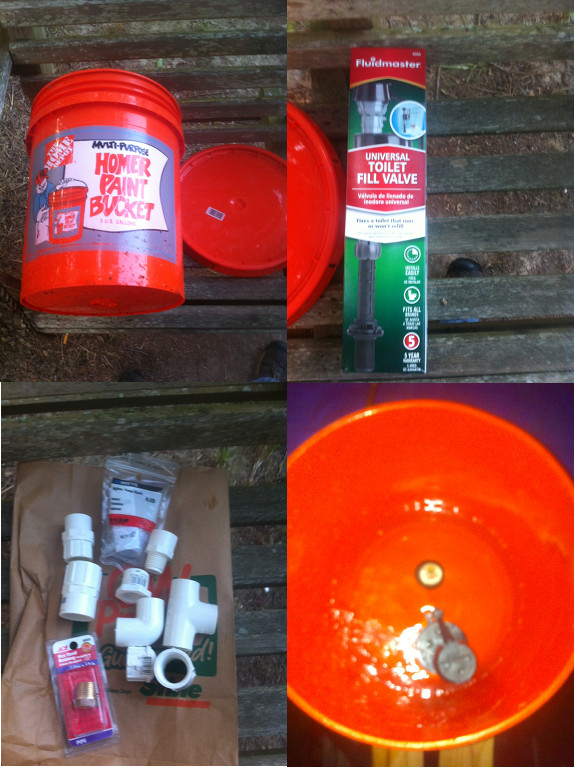
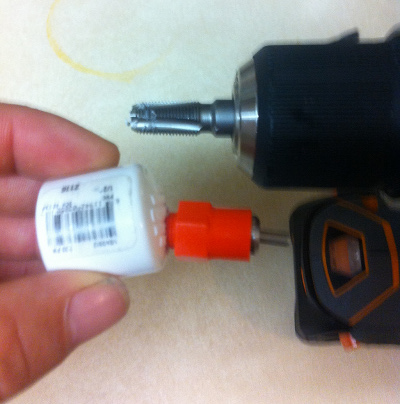 I used a toilet
tank fill valve assembly to autofill a bucket with water. I used part of an old broken
fill valve assembly to make the outlet in the bottom of the bucket.
From there, I used PVC pipe to go into the rabbit hutch.
I used a toilet
tank fill valve assembly to autofill a bucket with water. I used part of an old broken
fill valve assembly to make the outlet in the bottom of the bucket.
From there, I used PVC pipe to go into the rabbit hutch.
The chicken waterers seem to
be 1/8 male tapered pipe threads, so I used a drill bit and tap to
thread some PVC end caps. The waterer nipples are then screwed into
these, and it seems to work pretty well. I drilled and tapped the end
caps at a bit of an angle to make it easier for the rabbits to drink
from them. I'd say it's about a 20
degree angle...and they seem to still seal OK.
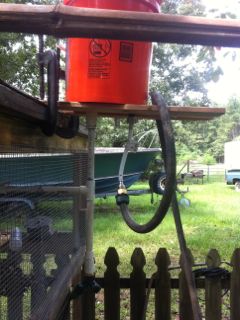 The bucket is suspended above the
hutch to give head pressure, and a benefit during dry times is
that we have a drip line that comes off the bucket to water some nearby
plants. This also keeps the
water in the bucket a bit fresher for the rabbits. There's a Y adapter
and shut off so we can drain the bucket and/or shut off the drip line.
The bucket is suspended above the
hutch to give head pressure, and a benefit during dry times is
that we have a drip line that comes off the bucket to water some nearby
plants. This also keeps the
water in the bucket a bit fresher for the rabbits. There's a Y adapter
and shut off so we can drain the bucket and/or shut off the drip line.
So far, the rabbits seem to
take to it pretty well. And it makes keeping them well watered almost
no effort at all.
Dawn managed to catch this footage of one of our rabbits drinking a few days after the new system was installed.
Shannon and Dawn will be sharing their experiences with raising meat rabbits on Tuesday afternoons. They homestead on three acres in Louisiana when time off from life and working as a sys admin permits.
It was a great day for
sliding metal up a ladder.
A bit more sliding and we'll
have a complete roof sometime tomorrow.
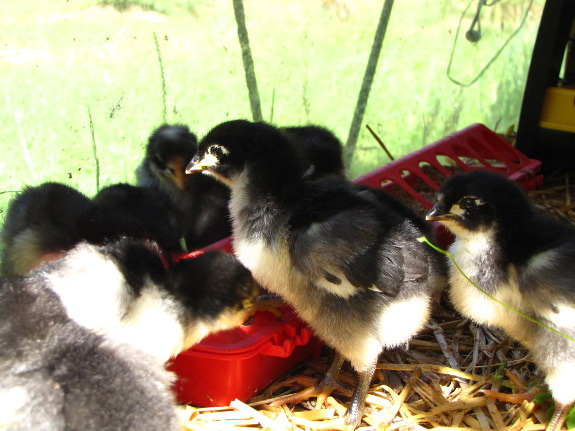
I was shocked to wake up
Tuesday morning to chilly weather in the mid 40s. While I'm never
really ready to see summer go, we've reached our freezer goals (20
gallons, mostly soup) and have changed over to drying
tomatoes for winter
treats.
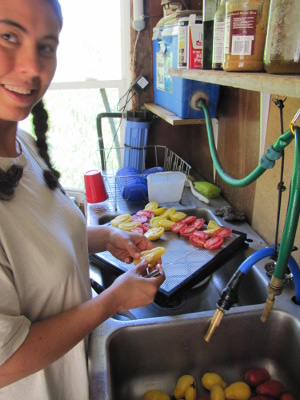 The fall garden is starting
to produce, and I've been zipping back through with another round of
weeding and mulching before the ground becomes too cold to enjoy
sinking my hands into. Winter weeds have snuck into small spots
of bare ground where I pulled the mulch back to plant seedlings, and I
want to stay ahead of them.
The fall garden is starting
to produce, and I've been zipping back through with another round of
weeding and mulching before the ground becomes too cold to enjoy
sinking my hands into. Winter weeds have snuck into small spots
of bare ground where I pulled the mulch back to plant seedlings, and I
want to stay ahead of them.
Now's also a good time
to kill mulch "lawn" areas that I want to fill with perennials this
winter or vegetables next spring. Mark's done a great job of
reclaiming some brambly patches with persistant mowing this summer, so
a simple kill mulch will be enough to turn those areas into arable
ground.
Despite planning ahead
for fall, winter, and even next spring, I'm far from ready for a
frost. Our average first frost date is October 10, but Bradley
predicts freezing weather to come before the end of September.
What do you think?
In the third selection
from Radical
Homemakers, Shannon
Hayes left the realm of theory and began to explore the similarities
she'd noticed among the radical homemakers interviewed. She
explained that radical homemakers had redefined poverty and wealth,
finding joy in free time, a strong marriage (if applicable), happy
friendships, a cohesive family, and good food rather than striving to
achieve the highest earning potential.
The chapter sought to
dispel the myth that the following facets of middle class life are
unachievable in a single- (or no-) wage-earner household:
- Transportation
- Housing
- Health care
- Child care
- Education
- Retirement
Many of the radical
homemakers' methods of achieving these goals on the cheap were
inspiring --- focusing on good food, low stress, and community bonds to
ensure your health, for example. Other methods were obvious ---
there's no need to pay for child care if at least one parent is at home
full time.
 But I was struck by how
middle class all of the assumptions (and participants) were. Many
of the radical homemakers chose to homeschool and not jump through the
expensive and time-consuming hoops required to get their kids into the
right preschool so they could get into the right private school and
then into the right college. And yet, 27% of those parents had
gone to grad or med school and 30% had a bachelor's degree (usually
listed as being from a prestigious private school), while only 3% and
6% had chosen the traditionally lower class options of the military or
a community college/technical school. (Actually, I suspect those
higher education percentages are underestimates --- anyone whose bio
didn't explicitly mention their education went into my "potentially
high school" category, but many of those people may simply have not
self-identified based on their school.) Those statistics tell me
that the majority of the participants in the study were culturally
middle class people who had access to options not available to the
average American.
But I was struck by how
middle class all of the assumptions (and participants) were. Many
of the radical homemakers chose to homeschool and not jump through the
expensive and time-consuming hoops required to get their kids into the
right preschool so they could get into the right private school and
then into the right college. And yet, 27% of those parents had
gone to grad or med school and 30% had a bachelor's degree (usually
listed as being from a prestigious private school), while only 3% and
6% had chosen the traditionally lower class options of the military or
a community college/technical school. (Actually, I suspect those
higher education percentages are underestimates --- anyone whose bio
didn't explicitly mention their education went into my "potentially
high school" category, but many of those people may simply have not
self-identified based on their school.) Those statistics tell me
that the majority of the participants in the study were culturally
middle class people who had access to options not available to the
average American.
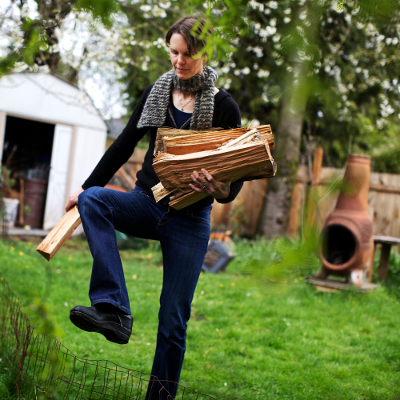 I could pick apart other
middle class assumptions (especially in the housing and income levels
of the radical homemakers), but I wanted to throw this week's thought
question out to my readers before you all roll your eyes and move
on. A couple of you commented on last
week's post to say
that when you're truly poor, you can't help working long hours to
support your family. With that in mind, I'm beginning to wonder
whether Radical
Homemakers really
represents a template that we can all use to live well on less, or
whether the book should be subtitled "how not to go quite as crazy as a
middle class American." We've
discussed this topic in relation to Walden previously, but
I thought it was worth rehashing with a more modern perspective.
What do you think?
I could pick apart other
middle class assumptions (especially in the housing and income levels
of the radical homemakers), but I wanted to throw this week's thought
question out to my readers before you all roll your eyes and move
on. A couple of you commented on last
week's post to say
that when you're truly poor, you can't help working long hours to
support your family. With that in mind, I'm beginning to wonder
whether Radical
Homemakers really
represents a template that we can all use to live well on less, or
whether the book should be subtitled "how not to go quite as crazy as a
middle class American." We've
discussed this topic in relation to Walden previously, but
I thought it was worth rehashing with a more modern perspective.
What do you think?
If you're still reading
along, we'll finish up the book by discussing chapters six and seven
(and the profiles if you feel so inclined) next Wednesday. Then
we'll take a week off before diving into a book that I've been itching
to savor for months --- The
Holistic Orchard by
Michael Phillips. I'm not sure how this text will do as a book
club selection since it's more factual and less philosophical than the  other ones we've been
discussing, but I have a feeling from the sections I've dipped into
that Phillips' new book will change the way we all look at fruit trees
and bushes, and I know it's one of the few books that will make the cut
and stay on my permanent bookshelf. So put in that interlibrary
loan request now and we'll start discussing chapter 1 of The
Holistic Orchard
on October 3.
other ones we've been
discussing, but I have a feeling from the sections I've dipped into
that Phillips' new book will change the way we all look at fruit trees
and bushes, and I know it's one of the few books that will make the cut
and stay on my permanent bookshelf. So put in that interlibrary
loan request now and we'll start discussing chapter 1 of The
Holistic Orchard
on October 3.
If
you want to be the first one on your block to see Walden Effect
readers' homesteading innovations in print, preorder your copy of The
Weekend Homesteader today.
